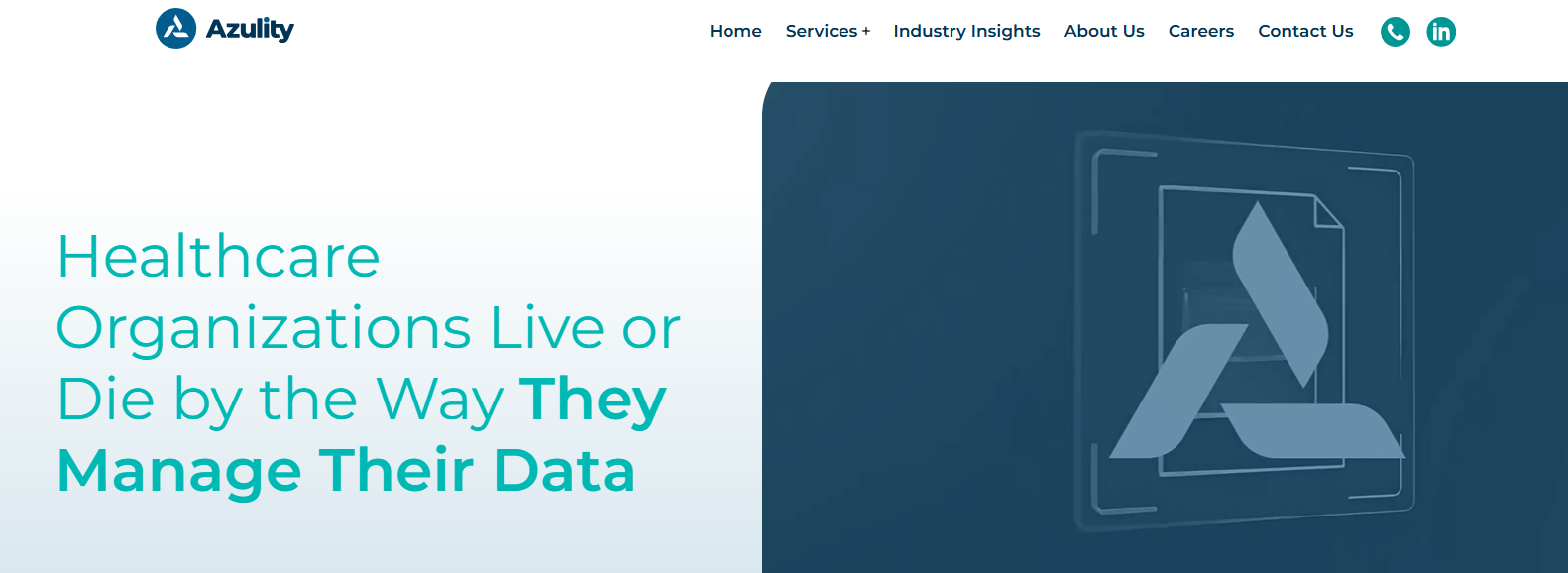A healthcare organization is hiring data scientists to help improve patient outcomes, but after reviewing dozens of applications, they realized they had no clue what to look for or how to hire data scientists. They needed to find a data architect, a skilled specialist who would create systems to help organize, structure, and manage the massive amounts of data their team would encounter.
Understanding data architect skills and how to identify them will help you find the right candidate to achieve your goals. This guide will unpack the importance of data architect skills for healthcare organizations and empower you to make the best hiring decision for your team.
Azulity’s provider credentialing services offer innovative data management solutions to help healthcare organizations access and organize vast amounts of data to improve their operations and boost patient outcomes.
Solution Architect Roles and Responsibilities


Solutions Architects, or Solutions Designers or Engineers, are IT professionals with expertise in technology and business. They analyze an organization’s needs and create solutions to help it achieve its objectives. Solutions Architects work closely with stakeholders to understand requirements, assess existing systems, and develop detailed plans for implementing technology solutions to enhance business performance.
Key Responsibilities of a Solutions Architect
The responsibilities of Solutions Architects vary depending on the organization and project. However, here are some everyday duties of a Solutions Architect:
- Create and lead the process of integrating IT systems for them to meet an organization’s requirements.
- Conducted a system architecture evaluation and collaborated with project management and IT development teams to improve the architecture.
- Evaluate project constraints to find alternatives, alleviate risks, and perform process re-engineering if required.
- Update stakeholders on the status of product development processes and budgets.
- Notify stakeholders about any issues connected to the architecture.
- Fix technical issues as they arise.
- Analyze the business impact that confident technical choices may have on a client’s business processes.
- Supervise and guide development teams.
- Continuously research emerging technologies and propose changes to the existing architecture.
Understanding Business Needs and Objectives
The primary responsibility of a Solutions Architect is to understand the business needs and objectives thoroughly. Their expertise in unraveling complex requirements allows them to construct technology solutions that strategically align with and drive the organization’s goals. This ability positions them as indispensable assets to the organization’s success.
Analyzing Existing Systems and Recommending Improvements
Solutions Architects are entrusted with meticulously analyzing existing systems. By identifying potential areas of improvement, they can recommend modifications or enhancements that increase efficiency and productivity. Their keen eye for optimization allows them to drive continuous improvement within the organization’s technological infrastructure.
Creating Technical Documentation and Architectural Diagrams
It is another essential responsibility of a Solutions Architect. This task extends beyond bureaucratic documentation. It is fundamental to ensure that all stakeholders clearly understand the nuances of the solution. By streamlining implementation and operation, these architectural artifacts become invaluable tools in driving project success.
Evaluating and Selecting Suitable Tools and Frameworks
The solution architect’s responsibilities include evaluating and selecting the tools and frameworks that best suit the solution’s requirements. Their expertise enables them to optimize the design and implementation process, ensuring the chosen technology stack aligns seamlessly with the organization’s needs.
Coordinating with Stakeholders
Coordination and collaboration with diverse stakeholders are essential endeavors for Solutions Architects. They serve as vital liaisons, uniting disparate teams and fostering a shared understanding and vision. By adeptly managing and balancing stakeholders’ interests and expectations, Solutions Architects drive seamless project execution and cultivate a collaborative environment.
Overseeing the Implementation and Integration of Solutions
One of the Solutions Architects’ key responsibilities is overseeing solutions’ implementation and integration. They ensure the solution’s smooth fit within the existing architecture and the fulfillment of the defined business objectives. Solutions Architects contribute to successfully realizing the intended outcomes by providing guidance and direction throughout the implementation process.
Ensuring Technological Scalability and Compliance with Security Standards
Undoubtedly, Solutions Architects bear the critical responsibility of guaranteeing their design solutions possess two irreplaceable traits: technological scalability and compliance with stringent security standards. The ability to scale for future growth is imperative to avoid costly overhauls or system failures. At the same time, adherence to robust security protocols is paramount to safeguard sensitive data and prevent potential breaches.
Estimation of Project Outcomes
In pursuing project success, Solutions Architects wield their expertise to estimate crucial project outcomes. They meticulously analyze various facets such as cost, timeline, and expected returns, weaving together a comprehensive understanding of the project’s viability and potential. This estimation process is a crucial safeguard, ensuring that projects remain within budgetary and time constraints while aligning with the organization’s strategic objectives.
Azulity specializes in healthcare master data management and provider credentialing services, bringing proven expertise in implementing healthcare data solutions and credentialing across the US. Our comprehensive platform ensures consistent patient, provider, location, and claims data synchronization across all systems and departments. Key features include healthcare MDM, provider MDM, reference data management, credentialing, and provider enrollment.
We serve healthcare technology leaders – from CIOs and CDOs to VPs of data platforms and credentialing – helping them eliminate the costly problems of fragmented data systems. Book a call to learn more about our healthcare master data management services today!
8 Essential Solution Architect Skills Needed to Get Hired
![]()
![]()
1. Systems Integration and Architecture Design: The Ability to Create Cohesive Systems
In 2024, Solutions Architects must have a solid grasp on creating robust and scalable architectures. With the increasing complexity of digital ecosystems, they need to integrate various systems, platforms, and technologies to meet business needs. This skill requires an understanding software and hardware interactions, network design, and data flow. Solutions Architects who can create cohesive systems that are both flexible and secure will be essential in supporting the evolving technological landscape and driving organizational success.
2. Cloud Computing Expertise: Designing Cloud-Native Solutions
Cloud computing continues to dominate the IT industry, and in 2024, Solutions Architects with expertise in cloud services and infrastructure will be in high demand. Knowledge of leading cloud platforms such as AWS, Azure, and Google Cloud and the ability to design cloud-native solutions is critical.
This skill encompasses understanding the nuances of cloud economics, security, and compliance and the ability to leverage cloud technologies to enhance scalability, performance, and reliability. Solutions Architects skilled in cloud computing will be instrumental in guiding businesses through digital transformation.
3. DevOps and Continuous Delivery: Accelerating Time-to-Market
Mastery of DevOps practices and continuous delivery pipelines is crucial for Solutions Architects in 2024. This skill involves creating environments where development, operations, and testing can occur concurrently and harmoniously. Solutions Architects must understand how to automate processes, implement infrastructure as code, and optimize deployment strategies to accelerate time-to-market. Those proficient in DevOps can significantly improve collaboration between teams and ensure that software updates are delivered quickly and efficiently.
4. Security and Compliance Acumen: Building Secure Architectures
In an era of heightened cybersecurity threats and stringent regulatory requirements, Solutions Architects must prioritize security and compliance in their designs. This skill is more than just adding security features; it’s about embedding security into the architecture from the ground up. Solutions Architects need to be familiar with industry standards, data protection laws, and best practices for risk management. Ensuring architectures are secure by design and compliant with relevant regulations is critical in protecting organizational assets and maintaining customer trust.
5. Business Acumen and Strategy Alignment: Bridging Tech and Business
Business acumen is increasingly vital for Solutions Architects as they bridge the gap between technical possibilities and business objectives. In 2024, they must understand business strategies, financial modeling, and market dynamics. This skill enables them to align architectural decisions with the company’s goals, driving growth and competitive advantage. Solutions Architects with strong business acumen can articulate the value of technology investments and ensure that IT initiatives support overarching business priorities.
6. Communication and Stakeholder Management: Earning Team Trust
Effective communication and stakeholder management remain critical skills for Solutions Architects in 2024. They must convey complex technical concepts to non-technical stakeholders and build consensus across diverse teams. This skill involves active listening, clear articulation of ideas, and the ability to negotiate and influence decision-making. Solutions Architects who excel in communication can effectively manage expectations, foster collaboration, and drive successful project outcomes.
7. Adaptability to Emerging Technologies: Staying Ahead of the Curve
The technology landscape is constantly evolving, and Solutions Architects must be adaptable to stay ahead of the curve. In 2024, they should be curious and proactive in exploring emerging technologies such as artificial intelligence, edge computing, and the Internet of Things (IoT). This skill is about integrating new technologies into existing architectures and pivoting quickly when technological advancements present new opportunities or challenges. Solutions Architects who are adaptable and forward-thinking can help their organizations remain innovative and competitive.
8. Project Management and Leadership: Overseeing Complex Projects
Project management and leadership skills are essential for Solutions Architects, who often lead cross-functional teams in complex projects. In 2024, they must be adept at planning, executing, and overseeing projects from conception to completion. This skill involves setting clear goals, managing timelines, and allocating resources effectively. Solutions Architects with strong leadership abilities can inspire their teams, drive productivity, and ensure that projects align with strategic objectives, delivering value to the organization.
Related Reading
- Scrum Master Roles and Responsibilities
- What to Look for When Hiring a Project Manager
- Solution Architect Roles and Responsibilities
- How to Hire a Project Manager
- Project Executive vs Project Manager
- Mistakes to Avoid When Hiring Developers
- What to Ask When Hiring a Data Scientist
How to Hire a Solution Architect


Hiring a solution architect is an investment in the future. These professionals take on complex projects that can make or break your business. A solution architect helps you determine precisely what your project needs to succeed. They can analyze your goals and create a blueprint for success that includes technical and non-technical components. This ensures that all stakeholders understand the plan and can execute it accordingly. Solution architects also mitigate risks by monitoring potential issues throughout the project lifecycle.
Technical Proficiency
Look for candidates with a firm IT architecture and development grasp and familiarity with various programming languages and cloud technologies. Solution architects don’t need to know how to code every application that will be part of a project’s design. However, they should understand how these components work and how to customize them for specific business needs.
Analytical Skills
A solution architect is not just a technical expert. They must also be skilled at problem-solving and designing scalable systems that align with business objectives. During the interview, present candidates with hypothetical project scenarios and ask how they would approach the situation to gauge their analytical abilities.
Communication
Solution architects act as the bridge between business and technology. They must communicate effectively with technical and non-technical stakeholders, translating complex technical language into terms that business users can understand. During the interview, assess candidates’ communication and presentation abilities to ensure they can perform this vital function.
Leadership
Solution architects take the lead on projects and must be able to guide technical teams to success. Look for candidates with prior experience managing projects and leading teams to success. They should demonstrate the ability to navigate complex technical environments and mitigate risks to ensure project success.
Where to Find Solution Architects For Your Company


1. Azulity: A Niche Talent Source for Healthcare Data Solutions


Azulity specializes in managing healthcare master data, focusing on provider credentialing services. The company brings proven expertise in implementing healthcare data solutions and credentialing across the US. Azulity’s comprehensive platform consistently synchronizes patient, provider, location, and claims data across all systems and departments.
Key features include healthcare MDM, provider MDM, reference data management, credentialing, and provider enrollment. Azulity’s clients include healthcare technology leaders – from CIOs and CDOs to VPs of data platforms and credentialing – helping them eliminate the costly problems of fragmented data systems. If you’re hiring a solution architect to build or enhance a healthcare data platform, Azulity can connect you with experienced professionals to meet your needs.
2. Professional Networking Platforms
Professional networking sites are great resources for finding qualified solution architects. LinkedIn, for instance, allows you to post job ads and search for profiles titled “Solution Architect.” You can filter results by experience, location, industry, and more. GitHub and Stack Overflow also help you find qualified candidates, as these platforms allow you to look for developers and architects contributing to relevant projects.
3. Freelance Platforms
Freelance platforms can help find independent solution architects to hire for short-term or project-based work. Upwork and Toptal, for instance, host experienced professionals, including solution architects, to help businesses with specialized needs. Freelancer and PeoplePerHour also provide access to skilled contractors.
4. Job Boards
Posting job ads on job boards can help you find solution architects with the right skills and experience. Tech-specific boards like Dice, AngelList, or Hired attract candidates with a technology background. General job boards like Indeed, Monster, or Glassdoor are also great for posting openings to find qualified solution architects.
5. Consulting Firms
Consulting firms can be valuable partners in your search for an experienced solution architect. Firms like Accenture, Capgemini, or Infosys often have solution architects on staff that they can provide to your organization on a project basis.
6. Recruitment Agencies
Recruitment agencies can help you find qualified solution architects quickly. Specialized IT recruitment agencies can source candidates with the skills and experience you need to meet your project requirements.
7. Networking Events and Meetups
Attending industry-specific conferences, seminars, or meetups can help you connect with solution architects and other data professionals. Events like AWS re Invent and Microsoft Ignite attract large numbers of attendees, and you can find qualified candidates for your project needs.
8. Community Forums and Groups
Engaging in online communities can help you find solution architects and other data professionals. Consider visiting Reddit (r/sysadmin, r/aws) or Quora, where tech professionals discuss relevant topics.
9. Internal Talent
Before you look externally for a solution architect, consider if you have anyone in your organization who can fill the role. An existing team member understands your business requirements and can upskill to take on the solution architect role.
Related Reading
- Questions to Ask When Hiring a Programmer
- Hiring Dedicated Developers vs In-House Developers: What Is Better?
- Scrum Master vs Project Manager
- How to Hire a Software Developer
- Data Architect Vs Data Engineer
- How to Hire Programmers for a Startup
- Quality Analyst Interview Questions
- Data Architect Roles and Responsibilities
- Data Analyst Skills Needed
- Skills Required for Project Manager
- Quality Analyst Skills
- Data Architect Skills
Book a Call to Learn More About Our Provider Credentialing Services
Azulity specializes in healthcare master data management. We help healthcare organizations eliminate the costly problems of fragmented data systems. We serve healthcare technology leaders to synchronize patient, provider, and location consistently and claim data across all systems and departments. Our comprehensive platform brings proven expertise in implementing healthcare data solutions and credentialing across the US. Key features include healthcare MDM, provider MDM, reference data management, credentialing, and provider enrollment.
How to Hire Data Scientists
First, identify the skills and experience needed to fulfill your unique project requirements and hire the proper data scientist for your organization. For instance, to create a machine learning model, look for candidates with strong statistical and programming skills and experience with the tools and processes needed to build, evaluate, and deploy a model.
